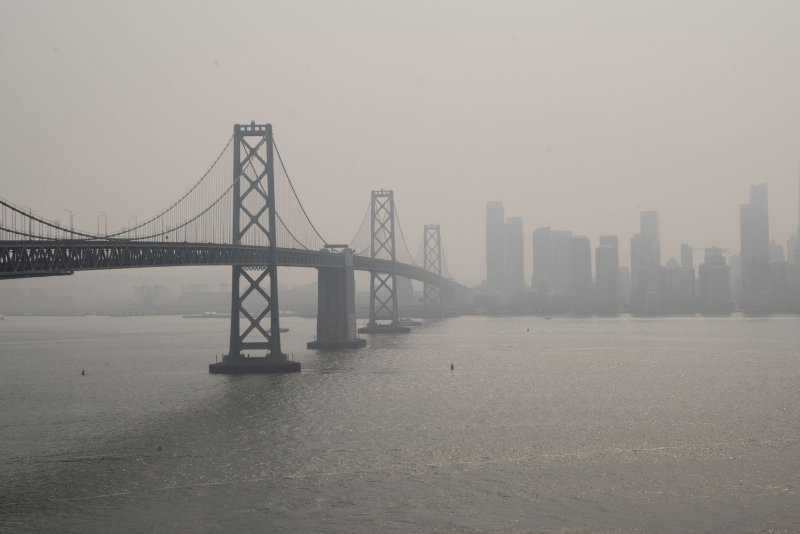
Smoke from fires in Northern California lowers visibility of the Bay Bridge and San Francisco as viewed from Yerba Buena Island in October 2020. File Photo by Terry Schmitt/UPI | License Photo
Nov. 2 (UPI) -- An institute based in Japan says that more than 4 million people worldwide die prematurely each year due to tiny particles known as PM 2.5 particulates that get into the lungs and cardiovascular system.
In recent years, scientists have become increasingly concerned about the impact that PM2.5 particulates have on air pollution and health.
A paper released Tuesday on the issue by a team from the National Institute for Environmental Studies in Tsukuba, Japan, coincides with the United Nations Climate Change summit that's being held in Scotland.
The Institute team, led by researcher Keisuke Nansai, mapped the microscopic particles from data gathered in 2010 and then projected their health impacts in 199 countries.
Among its findings, the report said the consumption of consumer goods from 19 of the Group of 20 nations were responsible for 78 000 premature deaths of infants worldwide. The report also asserted that global trade plays a role in the spread of PM2.5, in that "consumption in one country can lead to PM2.5 pollution in another."
And while most countries acknowledge they contribute to PM2.5 levels, there is little agreement on how much and how to assess each nation's financial responsibility, the report said.
The Institute warned about the dangers if world leaders do not take action to combat the pollution.
RELATED Study links air pollution to 6M premature births in 2019

An aerial view shows buildings engulfed in smog, in New Delhi, India, in 2017. File Photo by Harish Tyagi/EPA-EFE
"No studies have quantified the consumer responsibility of G20 nations for the substantial health impacts caused by atmospheric PM2.5.," the report said. "This lack of scientific knowledge risks delaying international collaborative efforts to safeguard the victims of the PM2.5 pollution.''
More broadly, the World Health Organization, too, blames air pollution for "millions of deaths and the loss of healthy years of life."
According to the U.S. Environmental Protection Agency, these particles come in many sizes and shapes and can be made up of hundreds of different chemicals. Some are emitted directly from a source, such as construction sites, unpaved roads, fields, smokestacks or fires.

An aerial view shows buildings engulfed in smog, in New Delhi, India, in 2017. File Photo by Harish Tyagi/EPA-EFE
"No studies have quantified the consumer responsibility of G20 nations for the substantial health impacts caused by atmospheric PM2.5.," the report said. "This lack of scientific knowledge risks delaying international collaborative efforts to safeguard the victims of the PM2.5 pollution.''
More broadly, the World Health Organization, too, blames air pollution for "millions of deaths and the loss of healthy years of life."
According to the U.S. Environmental Protection Agency, these particles come in many sizes and shapes and can be made up of hundreds of different chemicals. Some are emitted directly from a source, such as construction sites, unpaved roads, fields, smokestacks or fires.
Most particles form in the atmosphere as a result of complex reactions of chemicals such as sulfur dioxide and nitrogen oxides, which are pollutants emitted from power plants, industries and automobiles.
The New York State Department of Health says that fine particles also form from the reaction of gases or droplets in the atmosphere from sources such as power plants. These chemical reactions can occur miles from the original source of the emissions.

Heavy pollution, like this in Beijing in 2017, is the largest environmental cause of disease and premature death in the world, according to a study. File Photo by Stephen Shaver/UPI | License Photo
Because fine particles can be carried long distances from their source, events such as wildfires or volcanic eruptions can raise fine particle concentrations hundreds of miles from the event.
A report by The Lancet Journal released in September studied the connection between wildfires and PM2.5. The study included data from 749 cities in 43 countries and regions during 2000-16.
"Short-term exposure to wildfire-related PM2·5 was associated with increased risk of mortality," the report said. "Urgent action is needed to reduce health risks from the increasing wildfires."
No comments:
Post a Comment